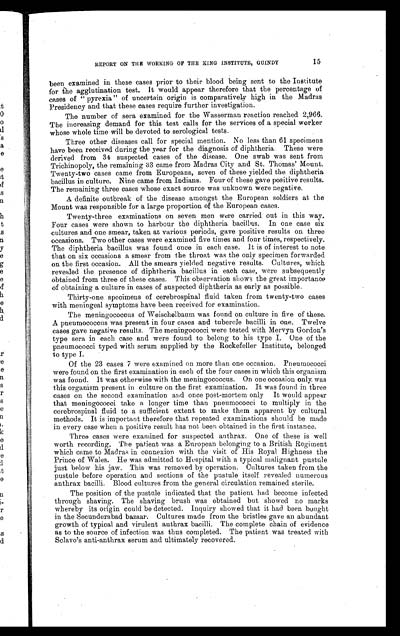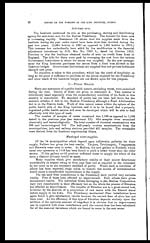Medicine - Institutions > Reports from medical colleges, schools and research institutions > Report of the King Institute of Preventive Medicine, Guindy > Reports on the working of the King Institute of Preventive Medicine, Guindy for the official year 1921-22 and the Micro-biological Section for the period from 1st January to 31st March 1921
(25) Page 15
Download files
Individual page:
Thumbnail gallery: Grid view | List view

REPORT ON THE WORKING OF THE KING INSTITUTE, GUINDY
15
been examined in these cases prior to their blood being sent to the Institute
for the agglutination test. It would appear therefore that the percentage of
cases of "pyrexia" of uncertain origin is comparatively high in the Madras
Presidency and that these cases require further investigation.
The number of sera examined for the Wasserman reaction reached 2,966.
The increasing demand for this test calls for the services of a special worker
whose whole time will be devoted to serological tests.
Three other diseases call for special mention. No less than 61 specimens
have been received during the year for the diagnosis of diphtheria. These were
derived from 34 suspected cases of the disease. One swab was sent from
Trichinopoly, the remaining 33 came from Madras City and St. Thomas' Mount.
Twenty-two cases came from Europeans, seven of these yielded the diphtheria
bacillus in culture. Nine came from Indians. Four of these gave positive results.
The remaining three cases whose exact source was unknown were negative.
A definite outbreak of the disease amongst the European soldiers at the
Mount was responsible for a large proportion of the European cases.
Twenty-three examinations on seven men were carried out in this way.
Four cases were shown to harbour the diphtheria bacillus. In one case six
cultures and one smear, taken at various periods, gave positive results on three
occasions. Two other cases were examined five times and four times, respectively.
The diphtheria bacillus was found once in each case. It is of interest to note
that on six occasions a smear from the throat was the only specimen forwarded
on the first occasion. All the smears yielded negative results. Cultures, which
revealed the presence of diphtheria bacillus in each case, were subsequently
obtained from three of these cases. This observation shows the great importance
of obtaining a culture in cases of suspected diphtheria as early as possible.
Thirty-one specimens of cerebrospinal fluid taken from twenty-two cases
with meningeal symptoms have been received for examination.
The meningococcus of Weischelbaum was found on culture in five of these.
A pneumococcus was present in four cases and tubercle bacilli in one. Twelve
cases gave negative results. The meningococci were tested with Mervyn Gordon's
type sera in each case and were found to belong to his type I. One of the
pneumococci typed with serum supplied by the Rockefeller Institute, belonged
to type I.
Of the 23 cases 7 were examined on more than one occasion. Pneumococci
were found on the first examination in each of the four cases in which this organism
was found. It was otherwise with the meningococcus. On one occasion only, was
this organism present in culture on the first examination. It was found in three
cases on the second examination and once post-mortem only It would appear
that meningococci take a longer time than pneumococci to multiply in the
cerebrospinal fluid to a sufficient extent to make them apparent by cultural
methods. It is important therefore that repeated examinations should be made
in every case when a positive result has not been obtained in the first instance.
Three cases were examined for suspected anthrax. One of these is well
worth recording. The patient was a European belonging to a British Regiment
which came to Madras in connexion with the visit of His Royal Highness the
Prince of Wales. He was admitted to Hospital with a typical malignant pustule
just below his jaw. This was removed by operation. Cultures taken from the
pustule before operation and sections of the pustule itself revealed numerous
anthrax bacilli. Blood cultures from the general circulation remained sterile.
The position of the pustule indicated that the patient had become infected
through shaving. The shaving brush was obtained but showed no marks
whereby its origin could be detected. Inquiry showed that it had been bought
in the Secunderabad bazaar. Cultures made from the bristles gave an abundant
growth of typical and virulent anthrax bacilli. The complete chain of evidence
as to the source of infection was thus completed. The patient was treated with
Sclavo's anti-anthrax serum and ultimately recovered.
Set display mode to: Large image | Zoom image | Transcription
Images and transcriptions on this page, including medium image downloads, may be used under the Creative Commons Attribution 4.0 International Licence unless otherwise stated. ![]()
| Permanent URL | https://digital.nls.uk/74936402 |
|---|
| Description | 13 titles. Describes research work and conditions, treatments, vaccine production, medical education, public health and disease outbreaks. Extensive tables show mortality rates and patient admissions. These - some from asylums, jails, dispensaries, civil and police hospitals – will be useful to epidemiologists. |
|---|




